If you try to list the most profitable and promising areas for doing business, then one of them will certainly be the automotive niche. That is, all kinds of goods or services, one way or another connected with cars and transport in general. Moreover, the variety of types of business in this area is simply amazing. Almost any person, regardless of level of training, availability of skills, experience and the amount of initial funds, can find something for themselves here.
Someone, if skills and experience are available, opens or STO. Others become vehicle insurance agents. Still others open car washes. Fourth conclude a contract of sale of vehicles. Fifths are trying to design cars. Sixth - produce spare parts. Etc. Etc. That is, having almost any skills, you can find them in the automotive environment. And make good money on it.
Today we talk about a serious automotive business. It's about creating your own. And the next publication, which will be published very soon, will introduce you to the production process. forged wheels.
The relevance of this business
The most important measure of relevance of any business idea is a good demand from potential customers. And here, in the case of disks, things are very, very good. The number of cars is growing every day. No crises prevent our people from having one, two, three cars in a family. And each of these machines needs spare parts and accessories. And given the fact that car manufacturers rarely spoil their customers with beautiful factory wheels, then many car owners, sooner or later, have a desire to dress up their iron friend. Rather - to "acquire" by buying a set of cool alloy wheels.
In addition to the aesthetic component, good alloy wheels carry other beneficial properties. As a rule, they are stronger, more durable and lighter than standard disks with which cars are equipped in factories. Strength and durability allow for many years not to think about replacing wheels. And lightness will make the car more tenacious and manageable on the road, and also save a lot of liters of fuel over the years of operation.
Add to this the affordable price that many models of alloy wheels can boast of, and you will receive an almost perfect automobile product.
The only minus (or, rather, the nuance) of the alloy wheels business is a large cash investment. Equipment, technology, raw materials - all this is quite expensive. But after all, many modern entrepreneurs resort to the help of investors or business angels. If you provide these people with a clear business plan, many of them may be interested in your idea and allocate the necessary funds to launch.
In addition, this minus is a plus. Due to the high financial threshold for entering this business, the competition in the market of manufacturers of alloy wheels is not so high. Each manufacturer can find its target audience by offering an interesting design or excellent value for money.
Where to begin?
From the search for a suitable plot of land and buildings located there. All this should be convenient for the location of several buildings of your future factory for the production of alloy wheels. The minimum land area required for the location of all buildings is from 1000 m². there will be an administrative building, a workshop building, a warehouse, parking lots, etc.
If you will be engaged in the transportation of finished products yourself, you will need cars for transporting disks. Trucks or light trucks, it all depends on the scale of production.
The next step is hiring employees. You will need technicians, designers, fitters, administrators, accountants, machine operators, drivers, movers, maintenance workers.
Alloy wheels are made from alloys of various metals. Most often, this is aluminum, less often magnesium. And very rarely use expensive titanium. Here you have a choice. You can create your own alloys. But for this you will need a laboratory, technologists and a lot of money for experiments. The advantage is that over time you can create a unique alloy that will have no analogues on the market and will have some fantastic properties. For example, very light and durable. The second way is the use of finished alloys, which today can easily be bought from third-party companies. This is a simpler and more affordable way to get raw materials for future alloy wheels.
Alloy Wheel Production Technology
At the heart of cast technology car rims - bringing the alloy to a liquid state. Therefore, even before starting a business, you need to decide exactly what metals you will work with. Just, depending on the metal, you will need different equipment.
Aluminum or magnesium melts at a temperature of 660 and 650 degrees Celsius. Therefore, standard equipment for melting metals is suitable here. But for titanium you will need a more powerful furnace, because its melting point is 1720 degrees. This is important to consider before starting an activity.
First, a chill mold is mounted in the foundry machine. In fact, it is just a steel mold. It is she who determines appearance (design) of the future alloy wheel. Next, the molten metal is fed into a casting machine. Under pressure, it tightly fills the chill mold and hardens there upon cooling.
Next, the finished casting (disc disc) is removed from the chill mold and sent for inspection. Each casting is visually inspected by a special person (controller), after which the workpieces are sent to an X-ray unit. If microcracks or a less dense metal structure are detected at this stage, the disk is sent for remelting.
In some cases, alloy wheels are processed and sent for painting. As a rule, this is done in order to give the product a non-standard appearance and does not affect technical specifications products.
That, in fact, is the whole production process. It remains only to stick the barcode, pack the disk and send it to the warehouse. Or shopping.
The implementation of the finished product
You can sell alloy rims through third-party stores. Then you have to sell the party at wholesale prices. The second option - selling discs through their own stores.
We all know that alloy wheels are better than steel (stamped), also many of us know that forged wheels are better than alloy wheels. But not everyone knows how forged wheels are forged. Unfortunately, no anvils and furs are used in this case ...
A small video retreat, for informational purposes. Actually the whole process:
Now, let's read an article from the magazine "Popular Mechanics" on how to make forged wheels.
We stand in the forging shop of the Stupino Metallurgical Company, a giant press rises above us, developing a force of 10,000 tons. A team of workers changes the equipment of the stamping press, and Alexander Lovchev, deputy head of the production of rims for automobile and motorcycle wheels of the Stupino Metallurgical Company (QMS), reveals to us the secrets of the production of forged wheels. “Actually‘ forged ’is not entirely accurate from a technical point of view, it would be more correct to call them disks made by hot forging in closed dies,” Alexander smiles. “But very few people can pronounce such a complicated name the first time, so the word‘ forged ’has completely taken root."
“These wheels are distant relatives of the aircraft,” Alexander continues. - In the early 1990s, many enterprises that worked in the Soviet era for aviation and space, with unique equipment and technology, were without government orders. And in order to survive, they were forced to switch to consumer goods. Someone began to make pans, and QMS - including rims. The technologies used are really aircraft - as in the production of some power elements of the structure of gliders. In this regard, Russian motorists were lucky: not all countries have such presses. And even where there is - such extremely expensive equipment, as a rule, works mainly for the aerospace (and not at all for the automobile) industry.
From casting to wheel
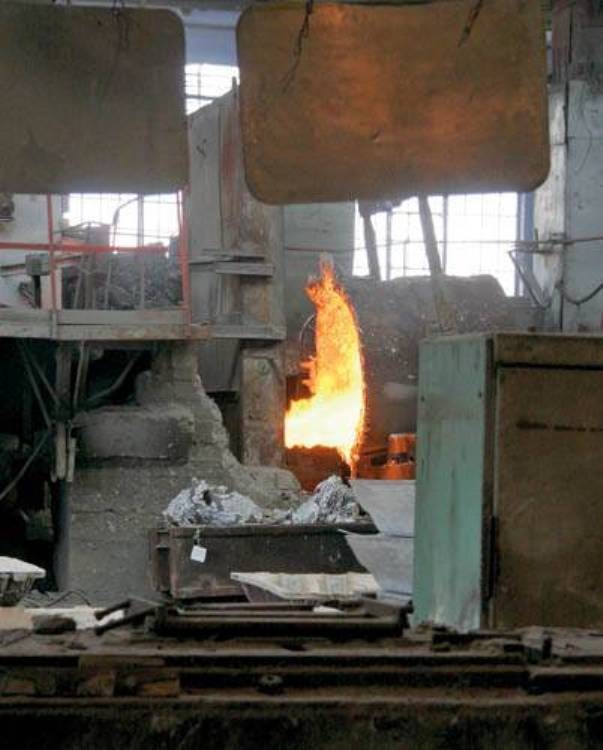
Foundry - the first stage of any metallurgical production
For disks, an aluminum alloy type AB is used with alloying additives of magnesium, copper, copper, silicon and manganese. It is not only high strength, but also plastic. Abroad, an analog of this alloy is usually called “aircraft grade 6061 aluminum” (aircraft grade Al 6061). The finished casting - a cylinder with a diameter of about 20 cm - is cut into pieces of the desired length (depending on the size of the future wheels), put into baskets and sent to the forge-and-press shop.
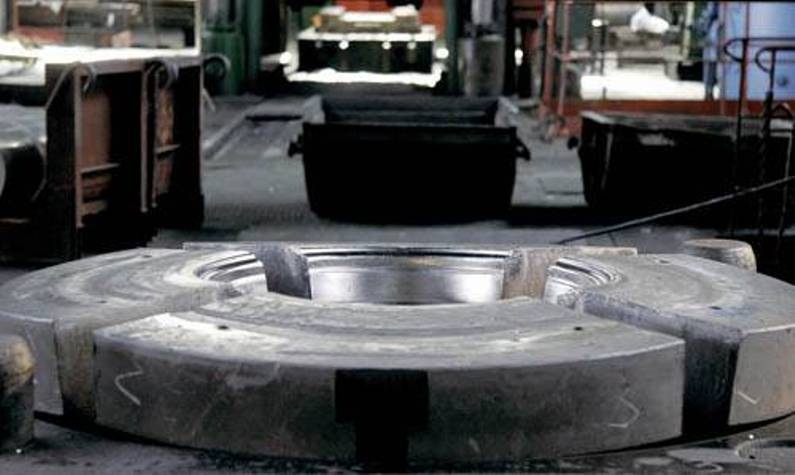
Sector stamp. For hot volumetric stamping, such stamps consisting of several sectors are used. With the final formation of the disc, the upper part of the stamp is lowered and the sectors converge. Excess metal is squeezed out through the cracks, forming a burr
There, these billets, while not even remotely resembling rims, are heated and “upset” by means of a press — flattened, turning into “pancakes” twenty centimeters thick and about half a meter in diameter. The process of further turning into wheels takes place in several stages. First, “pancakes” are heated to 430 ° C and, using a preliminary stamp (warmed up to about 350 ° C), they are turned into “pans” - preliminary blanks for automobile wheels.
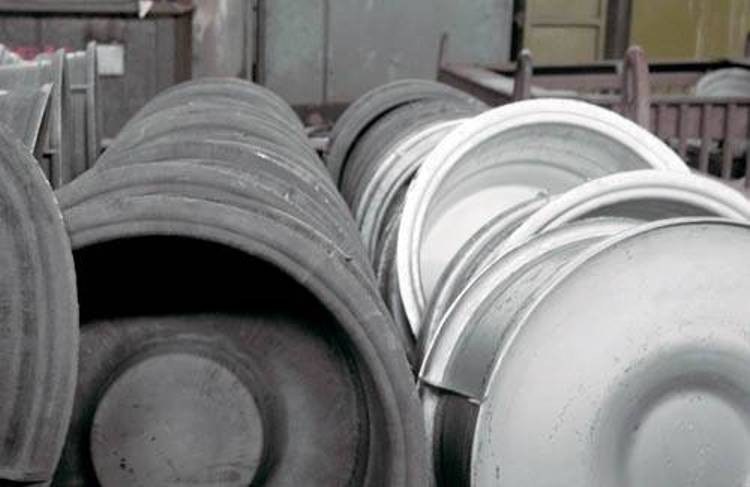
After heat treatment, the wheels are expected to be sent to the machining workshop
"Pots" are again sent to the furnace for heating, and then a special conveyor feeds them to the press with another stamp set - the final one. “The pause between the exit of the workpiece from the furnace and the stamping itself should not be more than 11 seconds, otherwise the workpiece will cool below the critical temperature,” Alexander explains. One of the workers lubricates the heated stamp with special grease, the other two deftly grab the “pan” with long tongs and transfer it to the mold. The upper part of the press goes down, rises - and now a finished wheel is taken out from under the press, except for the burr (excess material squeezed out during stamping). The first four stamped wheels after mastering a new stamp go to geometry control - only after that permission is given to use the stamp for mass production of discs.
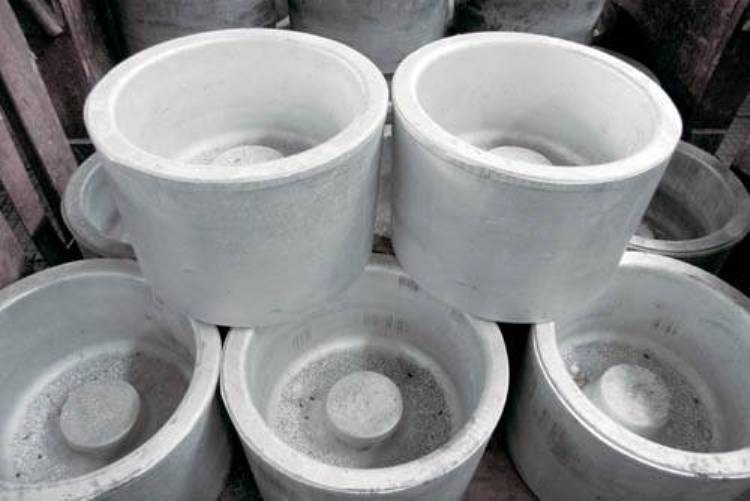
Cylindrical rollers are blanks for future motorsport wheels
A press with a force of 10,000 tons (there are two of them in the QMS) allows the manufacture of large-diameter disks. “We are the only company in Russia who has mastered the production of discs up to 22 inches in diameter! - proudly says Alexander. “You just don’t have to push them with less effort - you’ll have to heat the alloy to an almost liquid state, and this is no longer volumetric, but‘ liquid stamping ’- this is what we call high-pressure casting.”
Heat treatment and control
Despite the already apparent resemblance, the mechanical properties of the wheels are still far from those wonderful qualities for which "forging" is famous. And it is famous for its high strength (exceeds the strength of alloy wheels with a significantly lower mass), ductility (unlike alloy wheels, forged under high loads are deformed, but not destroyed) and elasticity (at moderate loads they are deformed elastically).
To get all this, heat treatment is needed. First, the wheels are quenched - evenly heated for several hours in an oven to 515C, and then quickly cooled, immersed in water. After quenching, the alloy already has the desired fine-grained-fibrous structure, but in order for the wheels to acquire the necessary mechanical properties, they must be “aged” - wait until the structure is leveled and the internal mechanical stresses are removed. Under normal conditions, this can take a couple of months, but in order not to lose time, the workpieces are artificially aged: they are kept in an oven at a temperature of 150-160C for about 12-14 hours, after which they are slowly cooled.
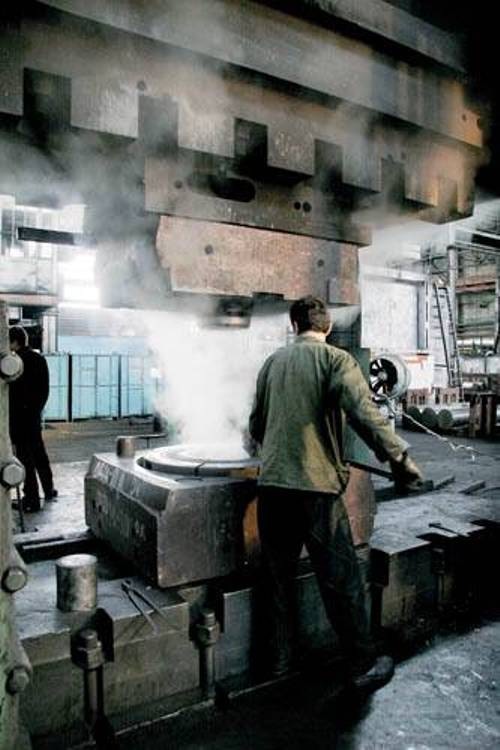
One of the workers with a brush lubricates the die tooling with special grease so that the finished part does not stick to the mold
After heat treatment, at least 10% of the workpieces from each batch are controlled. Their surface is etched: stamped defects and wrinkles are clearly visible on a light etched surface. And one wheel from the party is mercilessly cut, cutting out a special fragment from it - the so-called template. The template is ground and etched, and then carefully examined in the laboratory for defects in deformation, heat treatment and alloy uniformity. “Most often, defects are found in the hub part,” Alexander explains. “The most complex metallurgical point of view is the nature of deformations and thermal loads.” At this stage, the mechanical properties of the alloy are also monitored - the samples are fixed in a special tensile testing machine, with which the tensile strength, yield strength, elongation and hardness are determined. If the defects and values \u200b\u200bof the characteristics of the material do not fit into the tolerances, another wheel from the batch is examined. If a second check confirms these conclusions, then there has been a violation of the technological chain - and the entire batch is rejected. If all the parameters are normal, the batch of wheels goes to machining.
Made in Russia
An excess metal allowance is removed from a workpiece that already resembles a future wheel in shape, a nipple hole is drilled in the rim, and fixing holes for bolts are drilled in the hub part. Then the wheel is mounted on a CNC milling machine, which cuts the programmed design.
“Are there any design restrictions? In general, no - the picture can be anything, the wheel can be made very light and openwork, and the only limitation is the load that it must withstand, - Alexander answers my question. - Here, for example, this 15-inch drive weighs a little more than 5 kg, almost half the size of a stamped steel analog. And while its parameters significantly exceed the requirements of Russian GOST. By the way, such a mass is not a record - at one time we made the lightest 15-inch wheel in the world for the Japanese market - it weighed 3950 g. ”
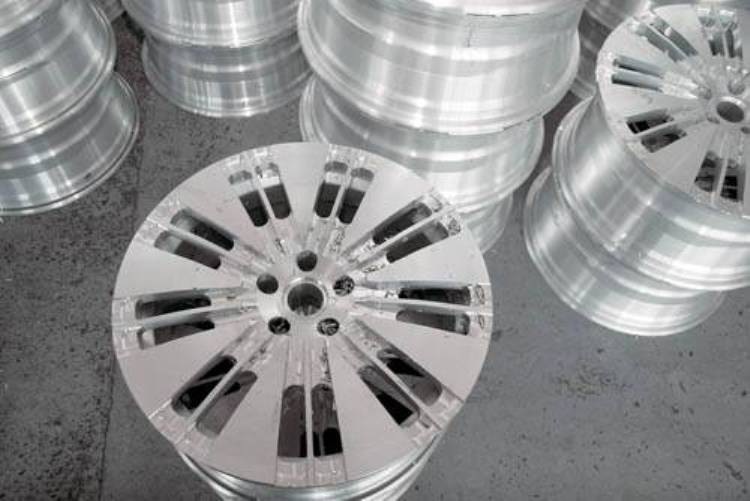
Almost finished wheel - there is only a locksmith and painting
“Some discs are polished after machining. For M&K discs, which represent our premium segment, these operations are performed abroad, ”continues Alexander. - For the rest, the usual plumbing is carried out - sharp edges are removed, and then the final control is made for compliance with the geometric dimensions of the drawing, rim runout and imbalance.
The last parameter according to GOST is not necessary to control, but we do it, and our ‘internal’ standard in this regard is two times more stringent than the Russian GOST. The QMS generally has a very strict and well-established quality control system - the aviation past affects: at every stage, from castings to the finished wheel, the details are tracked by marking. See the number on the wheel? After painting, final inspection and approval of the Quality Department, the wheel is packaged, and its factory passport will be kept with us for another ten years. How long does it take to make a disc? About a week of pure time, but if you take into account the production schedule, it turns out about a month. "
Russian technologies in the field of manufacturing forged wheels are fully recognized abroad. “Last year, at the German‘ Motor Show ’in Essen, the main European annual exhibition in the field of car tuning, several tuning studios exhibited very expensive cars - Bentley and Aston Martin - on our M&K discs," says Alexander. “Did visitors know that these discs are Russian?” I ask. "Oh sure! Brands ‘Made in Russia’ we’re not shy. We are proud of him. ”
By the way, in Russia there are quite a few manufacturers of forged wheels, but they have one big drawback, which is explained by the economic component. This drawback is the design, or rather its almost complete absence.
Look at the VSMPO wheels, good rimsbut the design is strong for the amateur.
Look at Slik - very few designs ...
And this is the situation with almost all forging manufacturers.
Cast horseshoes for a car horse
Choosing the best car wheel is an infrequent procedure for the average motorist. After buying a new car, we have been operating the installed native wheels for some time. But everything wears out and breaks, becomes outdated or becomes unusable over time. The reason for choosing new wheels may be the desire to use a second set of wheels for winter or summer tires, so as not to do regular seasonal tire fitting. Or you wanted to change the design of your car horse, and replacing the wheels is just one of the most popular solutions for tuning a car.
According to manufacturing technology, disks are divided into four types: stamped, cast, forged and prefabricated. The most common and affordable are stamped steel wheels. Forged and prefabricated wheels have a high cost, and therefore can not achieve popularity among motorists. Alloy wheels are the golden mean in terms of price, design, and workmanship among all existing types. Due to its advantages over stamped wheels, namely, lower weight and the ability to acquire any design forms, alloy wheels have become a welcome and fashionable attribute for any car. In addition to the fact that the car on alloy wheels looks more elegant and attractive, it is more comfortable when moving, and the load on the car's suspension is less.
Alloy wheels are popular among manufacturers. Therefore, there are so many of them on the market that it is extremely difficult to choose the best of this many-sided series for an ordinary motorist. We will present our rating of the best manufacturers of alloy wheels that have settled in the Russian market.
|
Model |
Price range, rub. * |
a brief description of |
|||||||||||||
|
Experts say these are the most durable alloy wheels. In the manufacturing process, special varnishes are used that protect against reagents that sprinkle roads in winter |
The legendary Italian brand with a leading position in the industry for over 40 years. A wide selection of models, various design solutions for every taste. |
Size range from 13 to 20 inches, a huge range from classic to exclusive models. The products have a certificate of quality of international standard TUV. |
The products of the German brand are aimed at lovers of an active, sporty driving style. By production the patented processing technology CPA (Ceramic Polished Acrylic) is used. |
High-quality German wheels. At making disc coversapply nanotechnology. As a result, they acquire self-cleaning properties. |
10 out of 10 |
||||||||||
|
The eminent Japanese company. It monitors all its production bases. This achieves an excellent quality of production, both in US factories and in factories, for example, the Philippines. Is a supplier of OEM discs for such brands as: Toyota, Mitsubishi, Nissan, Suzuki, Ford, Subaru, Mazda. |
All Replica alloy wheels are exact replicas of the original wheel models. |
The Japanese company, which has vast experience in the aviation industry, has transferred its innovative developments to the process of manufacturing alloy wheels. The company's products have excellent performance |
Production is carried out at factories in China, Taiwan and Singapore. Almost 15 years in the industry market. Extensive the lineup, multivariance of painting, low price made the wheels of this brand very popular in Russia. |
Produced by a Taiwanese company for the Russian market. The range of sizes and modifications allows you to use these wheels on almost all popular cars, ranging from Lada to Porsche. Products have passed the certification of Rosstandart. |
9.0 out of 10 |
||||||||||
|
SCAD alloy wheels have been produced at the factory in Divnogorsk, Krasnoyarsk Territory, for more than 10 years. The plant is considered one of the most high-tech in Russia. The plant produces more than two million discs per year. A wide range of models, high-quality performance and low price have made these discs popular in the Russian market |
K&K wheels are manufactured using German equipment from GIMA. The plant is located in Krasnoyarsk. It took K&K 20 years to take a leading position in the Russian market. More than 1.5 million discs are produced annually in accordance with GOST standards and requirements. |
9.4 out of 10 |
|||||||||||||
* - “Price range” - implies the price range for the range presented in Russia
Top European alloy wheel manufacturers
Alutec
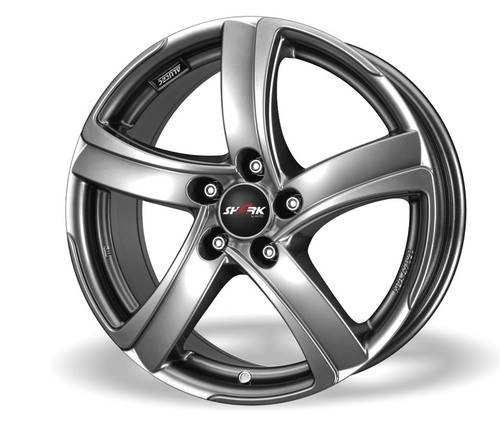
Photo: www.autoshinavrn.ru
7 900 rubles.
The disks of the German company Alutec among experts are recognized as the most durable. In addition to having an international TUV certificate, the company's products successfully pass various tests, for example, for cyclic load according to the ZWARP method, shock test with a design load exceeding by 60% and others. The range of alloy wheels is diverse and will satisfy the requirements of any motorist. There are also specially designed models for cars of auto giants, such as Mercedes, BMW, Audi, Volkswagen. Even painting is offered summer and winter. In winter painting, a special paintwork is used, which increases the anti-corrosion properties and prevents the destructive effect of reagents.
Advantages:
- strength;
- very light;
- wide range of;
- large selection of sizes;
- reliable paintwork.
Disadvantages:
- high price.
Reviews: “True German quality. When you take the Alutec disc in your hands, you are surprised at its lightness. But at the same time it is very durable. No pits and potholes could crush, bend or split it, although it happened differently. Tires scattered, and at least that drive. The price is biting, but these are the best alloy wheels, and true quality cannot be cheap. ”
Oz racing
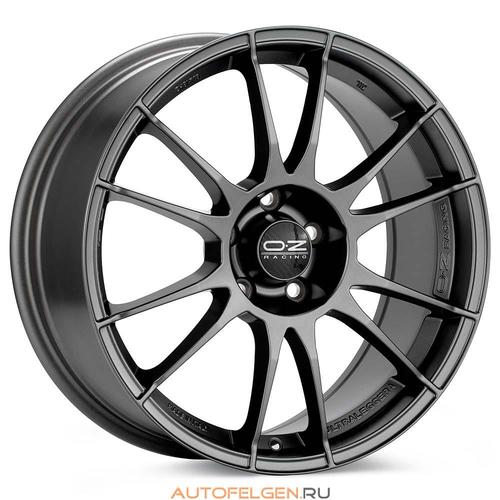
Photo: www.autofelgen.ru
Average price for this model: 17 500 rubles.
Impeccable quality, elegant style, exclusive design, the latest technology, a wide range - all this allows the Italian company OZ Racing to stay on top of the alloy wheel market. Its products are loved and respected not only by ordinary motorists around the world, but also by Formula 1 racers, various rallies and sports.
Advantages:
- high quality materials;
- a light weight;
- great design
- pass well pits and bumps;
- minimum damage;
- reliability.
Disadvantages:
- only high price.
Reviews: “I bought OZ Racing Ultraleggera wheels. Pleased with really light weight. My 15 "drive weighs only 5.4 kg. During use, it flew into the pits on our favorite roads more than once, but there are no dents or damages on the drives. The appearance is impressive. The car looks gorgeous."
Aez
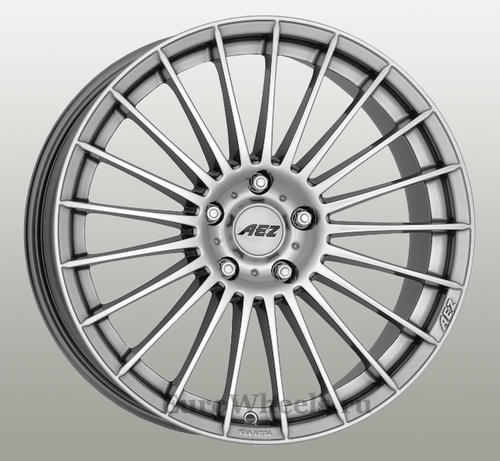
Photo: www.eurowheels.ru
Average price for this model: 13 000 rubles.
AEZ is part of the world-famous German holding company ALCAR. The use of high technology, innovative developments, technological quality control allowed this company to produce ultra-light alloy wheels for the past twenty years. A million disks ranging in size from 13 to 20 inches annually roll off the conveyors of the German giant. Design solutions can satisfy almost any motorist. But the main thing is the excellent quality of the products, confirmed by the international quality certificate TUV - the German independent test institute. Using the patented Nano tec® technology allows AEZ discs to have an antistatic effect, which in turn helps the disc surface to clean itself of dirt and water.
Advantages:
- ultra-lightweight discs labeled Lite tec® are available;
- antistatic coating that repels water and dirt;
- casting technology, ensuring the uniformity of the structure of the metal without pores;
- strong drives;
- a wide selection of models and sizes.
Disadvantages:
- price.
Reviews: “The wheels are standing . The best car wheels - the name is just a little confusing. The lacquer coating is so luminous even. Really repel dirt. The car itself is sometimes dirtier than a drive. Balanced normally. At tire mounting complaints about balancing did not cause. They look very stylish. Any passerby pays attention and peers into the logo. ”
Dotz
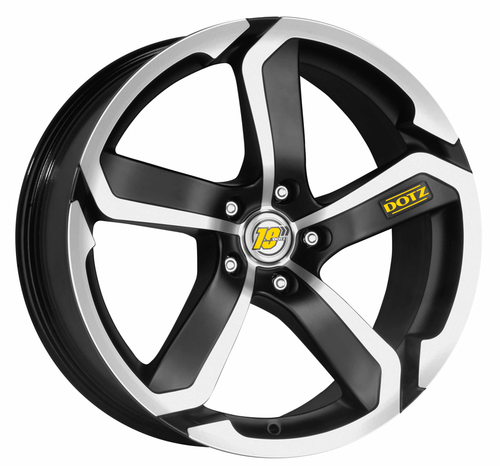
Photo: exshin.ru
Average price for this model: 11 900 rubles.
The products of the German company Dotz are aimed at lovers of an active driving style. The entire line is dominated by sports notes. For example, a popular model is specifically designed for drifting fans. If you want discs with a glow effect, then Dotz Touge Blaze is just for you. The fanciful design of the company's alloy wheels does not prevent them from possessing the most important criteria: strength and reliability. At the company's factories, the processing technology “CPA” (Ceramic Polished Acrylic) has been introduced, the essence of which is grinding the disc with tiny ceramic balls. As a result, the surface is smooth and shiny. Further, the products are covered with acrylic protection. DOTZ wheels are tested for strength right at the factory. A specific feature of Dotz discs is the use of various color bands: yellow, green, orange and white, which adds extra charm to the discs.
Advantages:
- attractive, whimsical, sophisticated design;
- strong, durable;
- large selection of sizes;
- suitable for sports driving;
- the quality matches the price.
Disadvantages:
- rather big price.
Reviews: “I have truly German . There was never a problem with them at the tire shop. It was not necessary to roll even once, although I had already gone to them for three seasons. On our so-called roads, drives have repeatedly proved that they are the best, reliable and strong. But beware of fakes and do not write nonsense later, riding in Chinese. "
DEZENT

Photo: c-a.d-cd.net
Average price for this model: 4,000 rubles.
Dezent wheels are known in the world for their high quality, while the price of them does not go off scale. In the manufacture of nanotechnologies are used, allowing products to acquire a self-cleaning effect. Dirt does not stick, but rolls off the surface. Dezent wheels showed excellent performance in winter. More than 20 design modifications, size range from 14 to 22 inches, various decoration options. These discs have everything to drive them was prestigious, fashionable, and, most importantly, reliable.
Advantages:
- fair price;
- winter use;
- practically do not require balancing;
- security;
- durability.
Disadvantages:
- not found.
Reviews: “I ride on discs. The disc is considered the flagship of the DEZENT line. What pleased us in the first place was the relatively low price. Even at first he doubted whether it was a fake. They put on the tire fitting without any weights, they said that they did not require balancing. After 2 years of use, the situation is the same. It was not necessary to roll. The coating was not tacked, although it traveled in the winter, and there was a dime a dozen chemicals on the roads. Lightweight, high-quality, German wheels and at a normal price. Satisfied like an elephant. "
Top Asian alloy wheel manufacturers
Enkei
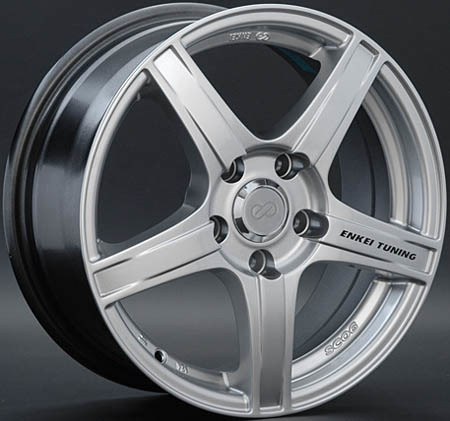
Photo: www.elpokupka.ru
Average price for this model: 5,000 rubles.
Enkei is a world famous Japanese company. The company's production facilities are located in Japan, India, Vietnam, and the Philippines. According to the company’s management, the quality of the products does not depend on the country of manufacture, since the corporation has a monitoring program for all production bases. Cars of such brands as Toyota, Mitsubishi, Nissan are leaving the conveyors on Enkei rims. McLaren Mercedes Formula 1 Team also uses Enkei wheels.
Advantages:
- good paintwork;
- strong;
- wide selection of designs;
- well balanced.
Disadvantages:
- not heavy, but not very light;
- in our market is dominated by Chinese production.
Reviews: “I bought a model to Kalina. They got up as if they were relatives. They look gorgeous. No balancing was required. Well-known Japanese brand, although it seems made in China. Generally recommend. "
Replica (Replay)
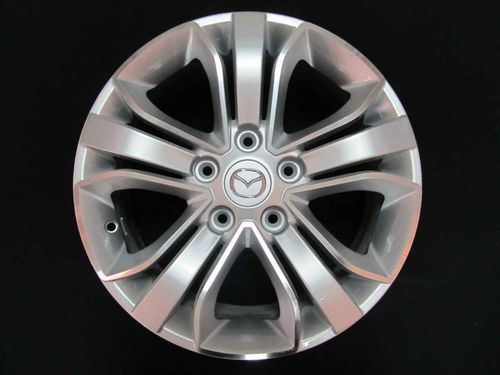
Photo: www.sibdomshin.ru
Average price for this model: 4 450 rubles.
For a long time, under the Replica brand, high-quality discs were produced at factories in Turkey, Taiwan and even Italy. But due to the large number of fakes, the company rebranded the brand and now its products come out under the Replay logo. All discs of this company are the most exact copies of the original discs, and at the same time they are of high enough quality. The advantage of these discs is that it is easy to replace the original ones with them, without overpaying at the same time and maintaining the car warranty.
Advantages:
- pass shock test with overload and test for cyclic load;
- an exact copy of the original, which allows the use of native bolts;
- as a rule, replacement occurs without additional staging rings;
- widest selection, easy selection by car
- quite reliable.
Disadvantages:
- and yet this is a copy.
Reviews: “By stupidity, one native disk was split intoPassat B7. As I found out the price of the original, I was very upset. Surprisingly, the dealership manager himself recommended choosing a Replica, saying that this would not affect the warranty. Replacements, frankly, did not feel. Neither visually nor functionally. I go and have already forgotten that one disc is a copy of the original. The paint didn’t peel off, there are no complaints about the tire on the tire. ”
Kosei
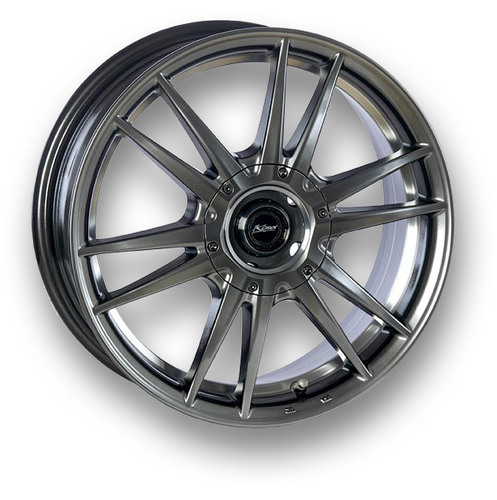
Photo: www.kosei-wheels.ru
Average price for this model: 5 050 rubles.
Since the beginning of the 50s, the Japanese company Kosei has been active in the aviation industry market. She was able to transfer the accumulated experience to the automotive industry, when she started the production of alloy wheels. Japanese quality and reliability characterize the products of this company. Kosei alloy wheels and their high performance were appreciated by the Japanese automotive giant Totota, who took them to the "armament" of their cars from the assembly line. The international quality certificate ISO 9001, which marks Kosei products, once again confirms the durability, strength and safety of Kosei alloy wheels.
Advantages:
- ease;
- high-quality materials;
- sustainable paintwork;
- strong rim;
- easy alignment;
- at a glance it can be confused with forged.
Disadvantages:
- complaints about the oxidation of the cap covering the bolts.
Average price for this model: 1 900 rubles.
IWheelz is a well-known brand in the automotive market. And although it exists not so long ago, its products were able to win the sympathy of Russian motorists. The company's production facilities are located in China, Singapore and Taiwan. Models are made with guaranteed accuracy. And due to the assortment of sizes and design drawings allows you to install them on many cars.
Advantages:
- price-quality ratio;
- nice appearance;
- sufficiently strong and durable;
- many common sizes;
- according to the parameters correspond to the original.
Disadvantages:
- requires balancing;
- no fasteners included;
- unusual hexagon nuts.
Reviews: “I changed my stamped for cast Iwheelz Shark. Arranged both price and visual quality. They look stylish, unusual. Installed at the service station, so troubles about nuts, fasteners, balancing did not affect me. After installation, the car behaved differently, control became much easier. 7.5 thousand rubles for a set of 16-inch alloy wheels, a popular manufacturer. Frankly, I’m not overjoyed. ”
LS Wheels
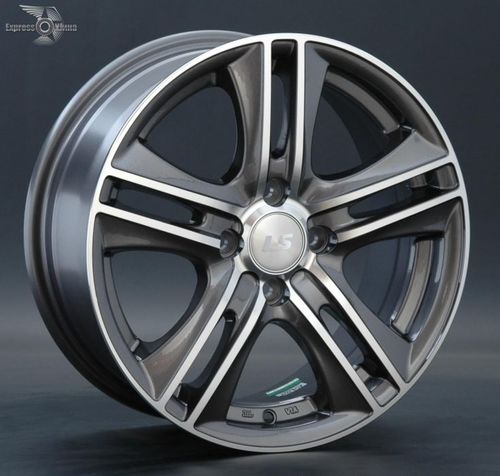
Photo: xn ---- 8sbxheocaa7a7e7c.xn - p1ai
Average price for this model: 3 300 rubles.
Taiwanese company whose products are mainly oriented to the Russian market. Due to the variety of styles, good quality casting and painting, as well as an affordable price, LS wheels are very popular among Russian motorists. LS Wheels products are certified by the German expert organization TUV.
Advantages:
- low price;
- high applicability to popular makes and models of cars;
- products are certified;
- a huge selection of sizes.
Disadvantages:
- compared with top brands, the quality, alas, is not up to par;
- the price is a bit overpriced.
- affordable price;
- reliability;
- strength;
- workmanship;
- good balance;
- strict design.
- heavy compared to peers;
- the metal is soft.
- during painting, SAM technology (smart molecules) is used to protect the disc from corrosion;
- 36 months warranty from the date of sale on the paintwork;
- lifetime warranty on metal and wheel construction;
- the widest choice of design and size;
- highest applicability.
- there are complaints about the softness of the original OEM discs installed in car factories (Priora, Lada Kalina).
Average price for this model: 3 300 rubles.
The first disk Scud was cast in 2004 in the city of Divnogorsk, Krasnoyarsk Territory. Since then, the company was able to become a priority supplier of Ford Motor and Volkswagen, increase the number of wheels to two million per year and arouse interest in its products not only among domestic consumers, but even among European ones. Scud wheels have undergone an independent TUV examination, which allows and permits their operation in Western Europe and the USA. The design of the Scud disks is like classic, strict, restrained shoes without frills, but at the same time evokes respect. These are not the lightest, but quite durable, corresponding to the current standards of the wheel.
Advantages:
Disadvantages:
Reviews: “For a long time I was tormented with the choice between KiK and Scud. Could not decide. A friend advised. Firstly, at a price they turned out to be cheaper than a similar KiK, and were impressed by the reviews. Now my impressions and sensations: the design is beautiful, the size fit without problems, balanced out with a bang !, the disks are strong enough, the paint keeps up well, I do not see any damage. The ride has become nicer. For the price of the best alloy wheels - I see no flaws. ”
K&K
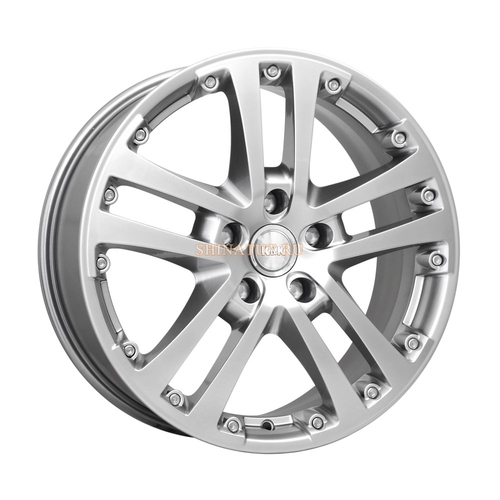
Photo: www.shinatut.ru
Average price for this model: 4 650 rubles.
K & K was founded in 1991 as a joint Russian-German enterprise at the facilities of the Krasnoyarsk Metallurgical Plant. The basis for the production was immediately selected the production of wheels from aluminum alloys. The technology of injection molding under low pressure, which is widely used in the world, has allowed to increase production and currently the range of KiK includes more than 60 designs and 400 sizes, and production volumes reach more than a million wheels per year. The production of original rims for the Volzhsky and Gorky automobile plants was launched. K&K products have passed state certification of quality and are extremely popular among Russian consumers.
Advantages:
Disadvantages:
Reviews: “I’ve been traveling for 4 years on KiK, I haven’t noticed any special problems. They have a good hold and match the declared load. Disc dealers claim that KiK is less likely to get married than Scud, but they are close in quality. The paintwork seems to be normal, a couple of scratches only showed up, but it doesn’t bother. ”
What alloy wheels are better to buy?
In addition to the best manufacturers of alloy wheels described in the article, it is also worth paying attention to such brands as Italian MAK and Momo, German BBS, Enzo, Rial and Borbet, Japanese Yamato, American Vossen, ADV.1, HRE Wheels. When choosing a disk, it is worth considering that, despite the apparent strength of the structure, a cast disk due to its granular structure can accumulate microcracks invisible to the eye, which at some point, or at peak load, can lead to cracking of the disk. Naturally, cheaper uncertified disc models have a greater risk of splitting. Therefore, be careful when operating alloy wheels. In addition, pay attention to the fact that the drive on the storefront and the drive on your car are completely different things, because its shape is ultimately affected by the shape, body kit and color of your car. Do not forget and take into account the important characteristics of the disk: the width and diameter of the rim, the number and diameter of the mounting holes, overhang (ET), the length of the bolts.
We hope that this article will help you make the right choice.
Have a nice shopping!
Today, in our country, despite the crisis, sales volumes of automobile transport are constantly increasing. In this situation, the manufacture of various spare parts and components for cars can become a very profitable business.
The relevance of the business idea for the production of alloy wheels today is proved by the presence of a large number of players in the market.
Among similar products, rims on wheels are considered to be one of the most demanded. If earlier, disks offered on the market were made in the vast majority of steel, now new disks made of alloys of light metals made using improved technology have appeared. Due to the peculiarities of manufacturing and materials, such disks became known as alloy wheels.
Prospects for the organization of small production for the manufacture of alloy wheels
Despite the fact that today there are many organizations involved in the production of alloy wheels, for a novice businessman, there is always a niche in this market segment, since the beginning of such an activity is accompanied by certain difficulties and requires quite large investments capital.
It is no secret to anyone that any production activity requires significant investments from the entrepreneur. But, with a well-written business plan, you can always find interested investors, or take a loan from a bank. Such a production line of business has serious development prospects, which are quite capable of attracting capital owners who are ready to invest in a worthwhile business.
The production of automobile rims can be called the only one in Russia among all, one way or another connected with automobiles, which is not affected by the negative characteristic of products manufactured by the Russian automobile industry. After the collapse of the USSR a large number of enterprises whose activities were previously associated with government orders.
Now the workshops of some of these enterprises produce alloy wheels for automobiles. Moreover, their production is carried out on equipment that was previously used in military production and aviation. It is very difficult to compete with similar companies that produce goods that combine quality and affordability and are in demand even abroad. It is difficult, but possible, since this market segment has not yet been mastered to the maximum. There are many foreign manufacturers, but the high cost of their products prevents their mass acquisition.
The current market situation suggests that for a novice businessman, the business idea of \u200b\u200borganizing a small production of wheels for a car is quite relevant. In this case, it will be more correct to specialize in the production of low-cost high-quality products oriented to the average buyer, and not in a specific region, but throughout Russia. There are other features of the light alloy wheel business that need to be considered.
What alloy wheels are
According to the manufacturing method and properties, alloy wheels are divided into:
- cast;
- forged;
- national teams.
Prefabricated discs assembled from individual parts and not differing in solidity are not widely used, so cast and forged can be considered the main types of discs. These types of discs are distinguished by manufacturing technology, the characteristics of the resulting product and its cost. Forged ones are slightly superior to cast ones in quality, but have a rather high cost. It is possible to reduce the cost of their manufacture only on the equipment of those factories that previously worked for the state. The combination of quick payback, less investment and the fact that they are more common than expensive forged ones makes it more preferable to create a business based on the production of alloy wheels.
Despite the high price, forged wheels also have their own buyer. But more often, large companies are engaged in the production of such discs. The increase in the number of owners of automobile vehicles allows quite successfully to exist and compete with other manufacturers.
In the process of operating his car, the owner periodically updates his wheels. The purchase of regular disks may be caused by their damage or by the desire to change the standard disks installed at the factory, which have an unattractive appearance. Each car has two sets of rubber, which are required and two sets of wheels. To roughly determine the demand for wheels in a particular city, you can analyze the number of existing car owners and estimate the volume of future auto sales.
Another option for such a business is custom-made discs, when an exclusive disc is machined from the base using milling equipment. It should be borne in mind that such a manufacturing method is considered very complex.
Where to begin?
Before starting any business, you should obtain the official status of an entrepreneur. Preferred forms of ownership, due to the simplified tax collection system used, are registration as an individual entrepreneur - IE, or as a limited liability company - LLC. With this form of ownership, tax deductions from incomes are 6 percent, and from profits - 15. Paperwork takes one month and costs 20 thousand rubles.
Organization of small production and personnel selection
To organize this type of activity will require an area equal to an average of 10 acres of land. In this territory, in addition to production, administrative, auxiliary and storage facilities should be located. In addition, there should be places for transport and convenient access. It is good if the novice businessman already has a suitable area or it is possible to arrange a rental at a bargain price.
The number of employees depends on the estimated production volumes. For a permanent job, it’s worth hiring the main labor force, the activity of which is directly related to the production process: machine operators, technical workers, turners, drivers, locksmiths, loaders and management personnel. To organize an accounting service, you can use outsourcing.
For starters, the usual work schedule is suitable - an 8-hour work day and a 5-day work week. Qualified personnel for such work is not easy to find. Workers should have the skills to maintain and use special equipment, the management team should be guided in the arrangement of equipment to properly configure and maintain it, technologists should improve manufacturing technology and determine the quality of the product.
There is no one-of-a-kind alloy for disks. It is important that the base metal in the alloy be light, preferably non-ferrous. Aluminum alloys are predominantly used, much less often - magnesium and titanium alloys. The use of these metals in pure form is not possible. The most widely used alloy of aluminum with silicon. Most organizations use ready-made alloys, but some are trying to develop something of their own.
Finding the best alloy requires investment and time, but ultimately, it can help to increase competitiveness. General questions on the organization of activities are the same, but the production of different types of discs is significantly different from each other.
Features of the alloy wheel business
Such alloy wheels are the most common, due to the relative cheapness of manufacture, affecting the final availability of the product for a wide range of consumers. The most common alloy of aluminum and silicon, also includes titanium and magnesium impurities. A disk made of such an alloy is resistant to corrosion, so it does not need to be painted or subjected to additional protective treatment.
Other types of alloys are also used. Magnesium alloy is used less often, since a wheel with a magnesium-based disk requires additional care. When choosing an alloy for manufacturing, it should be borne in mind that metals have different melting temperatures, because melting a metal before it turns into a liquid is an important part of the manufacturing process. It is optimal to use an alloy based on metal with a lower melting temperature threshold.
The use of the most common alloys - based on aluminum and magnesium, allows the use of standard equipment. The threshold for the transition of aluminum into a liquid form is 660 degrees Celsius, magnesium - 650 degrees. For comparison, working with titanium, which melts at a temperature of 1720 degrees, requires additional spending on the purchase of special furnaces and casting machines. The more rare use of titanium-based alloys is due not only to the high cost of the material itself, but also to the more expensive method of processing it. Despite this, titanium is one of the most suitable materials for discs.
The search for new alloys is still rare, so more often a finished alloy is purchased for manufacturing. The ingots are first sent to a casting machine, where they are processed. The resulting ingot goes through a quenching procedure - it quickly cools in water or texmassil. After this procedure, the metal acquires hardness, but remains brittle, viscous and has weak ductility.
All these properties are not suitable for further use. Therefore, it is necessary to heat the alloy below the limiting temperature, i.e. age and then cool. The product is almost ready, it remains only to give it the desired shape and parameters. This method of manufacturing does not imply further design processing of the disc, as this occurs during the casting process.
Sometimes, discs made of a certain alloy are not additionally thermally processed; the product immediately goes to a turner. When purchasing finished alloys, technologists must necessarily have information about the material in order to know how its characteristics will change during processing. Depending on the indicators, the process itself and the subsequent processing may differ.
Disks based on magnesium alloy have the lightest weight, but are more susceptible to corrosion, therefore, galvanizing or chromium plating is necessary as a protection. One of the protection options is painting, which is also used for disks from other alloys. Basically, the necessary equipment for the manufacture of alloy wheels includes:
- a casting machine - standard for all alloys or specializing in one, together with additional custom-made molds (seven hundred thousand rubles);
- furnace for initial melting (from four hundred thousand rubles);
- lathe - a simple manual (fifty thousand) or a multifunctional, programmable machine with a guarantee of maximum accuracy (four million rubles);
- painting technique - manual or automatic (from one hundred thousand rubles).
To make a product is not everything, before the product goes on sale, it must pass the control for tightness and quality of performance. Control is carried out by special equipment equipped with everything necessary for x-ray inspection and technical control. In addition to the main equipment, it is necessary to take care of devices for moving liquid metal from the furnace to the casting machine and for removing the blanks for cooling. The optimal workflow should be planned by engineers.
Features of the manufacture of forged wheels
Forged wheels are devoid of the main drawback of cast - less strength compared to classic ones made of steel. They combine strength and lightness. Despite the high cost, their long-term use brings great benefits in comparison with cheaper steel and cast. A wheel with a forged disk is lighter, which leads to a decrease in inertia, an increase in traction and, as a result, less fuel consumption.
But when buying, the car owner thinks more about the amount spent at a given time, so you need to try to achieve a competitive price for forged wheels by reducing production costs.
High manufacturing costs forged disk are associated not only with the need to use more expensive equipment, but also with large quantity waste. Surplus, and this is an average of 50% are not remelted, they can only be sold. Because of this, the quantity of material for the purchase increases.
As in the manufacture of cast discs, the use of aluminum-based alloys with impurities of copper, silicon and magnesium predominates in the forged industry. The requirements for raw materials for forged wheels are higher, because the base in this case should be immediately as strong and ductile as possible. Otherwise, the amount of surplus and marriage will increase.
For titanium-based alloys, specialized furnaces are needed that can heat presses for stamping to high temperatures with a regulated and wide heating range of the required area. For such a production, it is uncharacteristic to use our own alloys, since in addition to the manufacturing process, it still needs to be poured into certain forms.
Due to the peculiarities of production - volume stamping at high temperature, special blanks are purchased for the manufacture of forged discs in the form of long, small cylinder diameters - forgings. The forgings are already hardened and some entrepreneurs believe that they do not need casting machines in this case. Cylinders are cut into blanks of the right size and subjected to primary processing - they are heated and pre-stamped.
After the first stamping, they are heated in a furnace not to the maximum temperature and sent under a press with a new form. The distance from the furnace to the press should not be large so that the disc does not cool. After processing in the prepared solution, it is determined in a stamping machine. After this procedure, the disks are almost completely ready. They are once again heated, quickly cooled, heated again, after which they cool naturally.
Finishing - applying the desired pattern to the disc using a milling unit. All discs after the press are the same, they acquire differences at the final stage of the manufacturing process. The use of a milling cutter, which is based on program control, automates the work of manufacturing discs. The milling cutter can perform any task and allows you to quickly get the result.
The appearance of the product is as important as its other characteristics, so you should not save on this procedure. The disc can be coated with paint if necessary. This procedure, more often plays a decorative role, since most of the alloys used, can do without the use of additional corrosion protection. The list of necessary equipment for production halls for the manufacture of forged wheels includes:
- a molding machine - not required, but desirable (seven hundred thousand rubles);
- a furnace with a lower maximum temperature regime (from two hundred thousand rubles);
- paint installation (from one hundred thousand rubles);
- installation for plasma cutting (from three hundred thousand rubles);
- equipment for stamping in duplicate (from one million rubles);
- milling installation (from two million rubles)
The first batch must pass control in order to determine product quality. If after the inspection no shortcomings are identified, you can continue the further production.
To summarize
Potential buyers have long appreciated the benefits of alloy wheels compared to classic ones made of steel. The demand for light alloy wheels has long exceeded the demand for steel products. Alloy wheels are slightly inferior to steel in strength, and this is their only drawback. Forged products can be considered ideal.
If you properly organize the production activities for their manufacture, then their price will quite become accessible to a wider circle of consumers and will certainly be lower than the cost of cast and steel products of foreign manufacture. Geometric accuracy and light weight light alloy wheels proven to improve operation different kinds motor transport.
It is also important that alloy wheels can be given any appearance. A variety of design solutions does not harm the design of the wheels. This is another reason for the popularity of such discs among car owners who are not comfortable with the unattractive appearance of factory-made discs. After mass production is debugged, it is possible to organize the production of unique products (forged wheels) to order.
The composition of the alloys used in the manufacture of such disks has a positive practical effect. Wheels made using light alloys are less affected by weather conditions and are less affected by vehicle operation. The properties of the underlying alloy contribute to a greater heat dissipation from the braking system, and as a result, wear is reduced and fuel consumption is reduced. Forged products, among other things, are characterized by maximum strength and elasticity.
You can sell discs to wholesale customers and additionally through your own retail store. Attractive for customers may be low cost, without additional margins and the ability to manufacture products to order. By developing these two areas of business, you can get a tangible income.
The cost of obtaining one disk is 1.5 thousand rubles, with retail sales, its cost is about 5 thousand rubles. A simple calculation demonstrates the prospects for the development of a business for manufacturing alloy wheels. This is especially true for the manufacture of forged products, which will be much cheaper than foreign products.
Usually distinguishsteel rims and alloy wheels. In alloy wheels of light alloys, only aluminum and magnesium are used. Magnesium disks in ordinary cars are extremely rare due to their high cost, and most importantly, low corrosion resistance.
The main advantage of cast aluminum disks over steel is the ability to obtain a diverse design, high dimensional accuracy, as well as optimal static and dynamic mechanical characteristics.
Reducing the weight of aluminum rims compared to steel is one of their advantages, but often not decisive. In some cases, the weight of cast aluminum rims is equal to or only slightly lighter than standard steel rims with a simple design.
Aluminum rims: cast or forged
Most aluminum rims are cast or forged. A small number of disks, mainly for "luxury" and sports cars, are made from several components and using mixed technologies with the use of casting, forging, stamping, pressing, rolling, welding and others.
Cast aluminum rims
When it comes to alloy wheels, they usually only mean aluminume alloy wheels. Steel wheels are made not by casting, but by stamping, and magnesium alloy wheels are used only on exclusive cars for the reasons mentioned above.
Figure 1 - Cast wheels of the Air Force
Casting aluminum rims
For the production of aluminum rims used various methods casting. The quality of the cast rim, external and internal, depends on the method. The choice of casting method is mainly determined by the quality of the cast microstructure (for example, porosity), the types of aluminum alloys used and the heat treatment conditions. All this determines not only the strength and reliability of the rims, but also affects the level of quality of their appearance.
Basic casting methods for rims
The main casting methods used in the manufacture of rims are as follows:
- low pressure casting is the main method;
- chill casting - less commonly used;
- back pressure casting is even less common.
Sometimes technologies are used that combine casting with forging and stamping.
Chill casting
Generally speaking, injection molding, when the metal is pumped into the mold, is more preferable than simply pouring into it under the action of gravity. However, chill casting is still a very relevant casting process for the production of rims. Chill casting is cheaper, it is used mainly when they are not chasing weight loss, but want to get an original design. Since this process relies solely on gravity to fill the mold, the cast structure usually has more defects (for example, porosity) than that obtained by injection molding. Therefore, chill cast discs are usually heavier in order to provide the required strength.
Wheel casting under low pressure
Most alloy wheels are manufactured by low pressure casting (Figure 2). The low-pressure casting method uses a relatively low pressure (about 2 bar) in order to achieve quick filling of the mold and to obtain a denser microstructure, and, consequently, higher mechanical properties compared to chill casting. In addition, this technology provides somewhat higher performance (Figure 3).
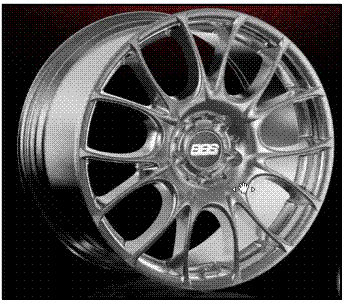 Figure 2 - BBC Aluminum Cast Wheel, Low Pressure Die Casting
Figure 2 - BBC Aluminum Cast Wheel, Low Pressure Die Casting
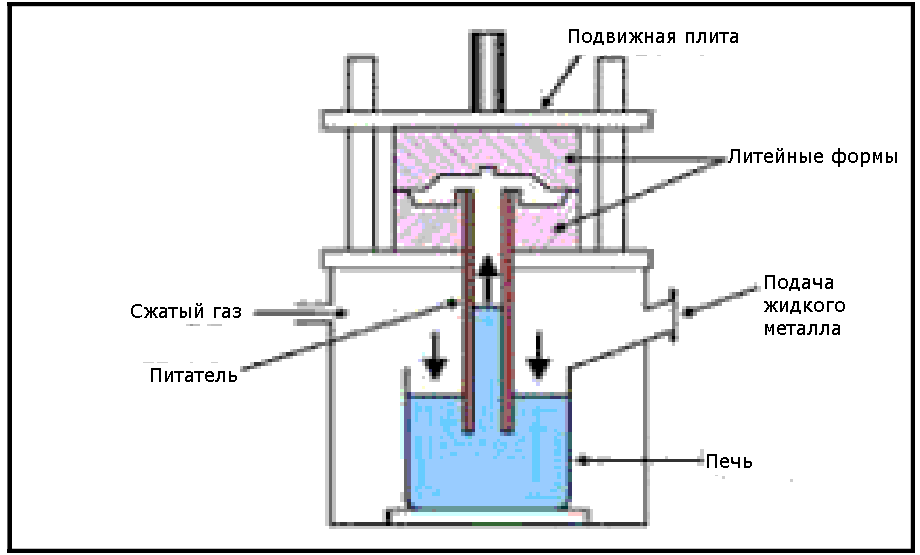 Figure 3 - Diagram of a method for casting rims under low pressure
Figure 3 - Diagram of a method for casting rims under low pressure
Other wheel casting methods
In addition to the classic low-pressure casting method, numerous technological options are used that are optimized for the production of rims. For example, even lighter and more durable rims are obtained when special equipment is used that provides higher casting pressure.
Hollow rims
An interesting new development is BBC's patented “air inside technology” method. Its main idea is to use hollow chambers and spokes in the design of the rim instead of solid metal. The result is a lighter wheel with better dynamics and driving comfort. In addition to casting, this technology includes operations such as molding and welding.
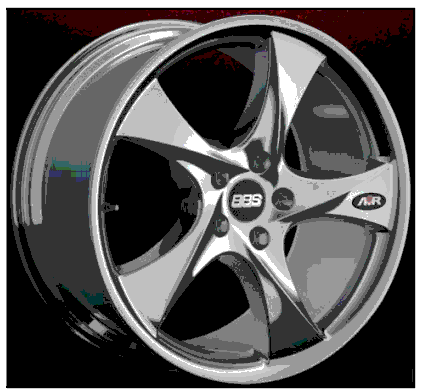 Figure 4– BBC Aluminum Hollow Wheel with Air-Inside Technology
Figure 4– BBC Aluminum Hollow Wheel with Air-Inside Technology
Quality control of alloy wheels
Each cast disk is subjected to x-ray inspection, and then is usually subjected to heat treatment and machining. After that, the surface of the discs is subjected to special preparation for painting and a paint or protective coating is applied. Then, samples from a statistical sample of disks undergo three-dimensional dimensional control, dynamic balancing tests, fatigue and impact strength tests.
Wheel Alloy Requirements
A number of requirements are imposed on materials for rims, which may contradict each other.
Foundry alloy must have good casting properties:
- flawless filling of the mold
- lack of sticking of metal to the mold,
- minimal tendency to hot cracking and shrinkage.
The material must have
- high ability to withstand mechanical shocks (ductility, impact strength).
Wheel material must have
- high corrosion resistance in both normal and salt atmospheres.
Disc material must have
- high fatigue strength.
Aluminum-silicon alloys for rims
In accordance with these requirements, pre-eutectic aluminum-silicon alloys with a silicon content of 7 to 12% are used for the manufacture of rims. These alloys also have additives of varying amounts of magnesium to provide a good combination of strength and ductility. In addition, these alloys have a low content of iron and other impurities.
Aluminum AlSi11Mg Alloy
Until the 1980s, AlSi11Mg alloy with a silicon content of 11–12% was used in Germany and Italy. This alloy has very good casting properties, especially in relation to filling molds and minimal shrinkage. On the other hand, this chemical composition of the aluminum alloy does not provide it with a sufficiently high strength and fatigue limit, which would further reduce the weight of the rim.
 Figure 5 - AlSi11Mg aluminum alloy cast wheel (Borbet)
Figure 5 - AlSi11Mg aluminum alloy cast wheel (Borbet)
Aluminum Alloy AlSi7Mg0.3 (A356)
Currently, the standard alloy for the manufacture of rims is cast aluminum alloy AlSi7Mg0.3, which is better known as alloy A356, with additional modification of strontium. For the first time this alloy was used for the manufacture of rims in France, and heat treatment was not used.
However, the advantage of this AlSi7Mg0.3 alloy is precisely that it is thermally hardenable, and this allows the discs to provide additional strength. In the United States and Japan, this alloy was used from the very beginning with heat treatment of T6, that is, in the state after quenching and artificial aging.
Thermal hardening of aluminum rims
The graphs of Figure 6 show the dependence of the strength properties of the sodium-modified AlSi7Mg alloy on the magnesium content. The strength characteristics of AlSi7Mg0.3 alloy give the best combination of fatigue strength and elongation. With an increase in the magnesium content, the fatigue strength practically does not increase, the elongation decreases significantly.
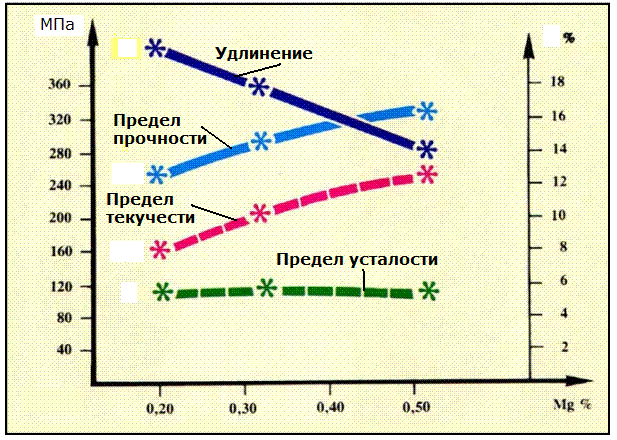 Figure 6 - Tensile strength, yield strength, elongation and fatigue strength of AlSi7Mg-T6 aluminum cast alloy
Figure 6 - Tensile strength, yield strength, elongation and fatigue strength of AlSi7Mg-T6 aluminum cast alloy
Similar studies have been performed for various silicon contents. It has been established that with an increase in the silicon content, the ductility of the alloy decreases, especially at a low solidification rate in places of thickening. Nevertheless, alloys with a silicon content of 11-12% continue to be used in those cases where increased fluidity of the aluminum melt is required.
Of great importance for the fatigue strength of AlSi7Mg alloy is the level of its porosity in the casting. Figure 7 shows the dependence of the fatigue strength of the AlSi7Mg0.3 aluminum alloy on the maximum pore size in the material of the test samples.
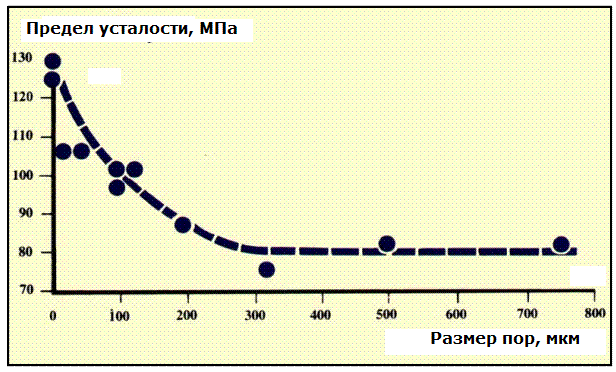 Figure 7 - Fatigue strength of an aluminum cast alloy AlSi7Mg0.3
Figure 7 - Fatigue strength of an aluminum cast alloy AlSi7Mg0.3
depending on pore size




